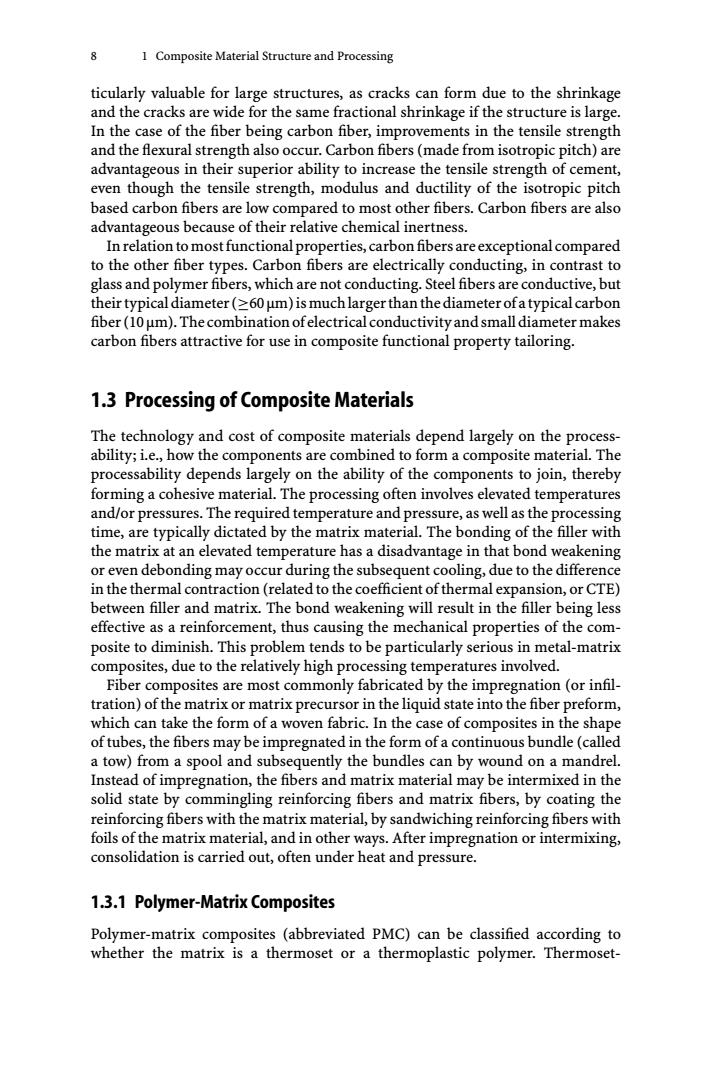正在加载图片...

8 1 Composite Material Structure and Processing ticularly valuable for large structures,as cracks can form due to the shrinkage and the cracks are wide for the same fractional shrinkage if the structure is large. In the case of the fiber being carbon fiber,improvements in the tensile strength and the flexural strength also occur.Carbon fibers(made from isotropic pitch)are advantageous in their superior ability to increase the tensile strength of cement, even though the tensile strength,modulus and ductility of the isotropic pitch based carbon fibers are low compared to most other fibers.Carbon fibers are also advantageous because of their relative chemical inertness. In relation to most functional properties,carbon fibers are exceptional compared to the other fiber types.Carbon fibers are electrically conducting,in contrast to glass and polymer fibers,which are not conducting.Steel fibers are conductive,but their typical diameter(>60 um)is much larger than the diameter ofa typical carbon fiber(10 um).The combination ofelectrical conductivity and small diameter makes carbon fibers attractive for use in composite functional property tailoring. 1.3 Processing of Composite Materials The technology and cost of composite materials depend largely on the process- ability;i.e.,how the components are combined to form a composite material.The processability depends largely on the ability of the components to join,thereby forming a cohesive material.The processing often involves elevated temperatures and/or pressures.The required temperature and pressure,as well as the processing time,are typically dictated by the matrix material.The bonding of the filler with the matrix at an elevated temperature has a disadvantage in that bond weakening or even debonding may occur during the subsequent cooling,due to the difference in the thermal contraction(related to the coefficient of thermal expansion,or CTE) between filler and matrix.The bond weakening will result in the filler being less effective as a reinforcement,thus causing the mechanical properties of the com- posite to diminish.This problem tends to be particularly serious in metal-matrix composites,due to the relatively high processing temperatures involved. Fiber composites are most commonly fabricated by the impregnation(or infil- tration)of the matrix or matrix precursor in the liquid state into the fiber preform, which can take the form of a woven fabric.In the case of composites in the shape of tubes,the fibers may be impregnated in the form of a continuous bundle(called a tow)from a spool and subsequently the bundles can by wound on a mandrel. Instead of impregnation,the fibers and matrix material may be intermixed in the solid state by commingling reinforcing fibers and matrix fibers,by coating the reinforcing fibers with the matrix material,by sandwiching reinforcing fibers with foils of the matrix material,and in other ways.After impregnation or intermixing, consolidation is carried out,often under heat and pressure. 1.3.1 Polymer-Matrix Composites Polymer-matrix composites (abbreviated PMC)can be classified according to whether the matrix is a thermoset or a thermoplastic polymer.Thermoset-8 1 Composite Material Structure and Processing ticularly valuable for large structures, as cracks can form due to the shrinkage and the cracks are wide for the same fractional shrinkage if the structure is large. In the case of the fiber being carbon fiber, improvements in the tensile strength and the flexural strength also occur. Carbon fibers (made from isotropic pitch) are advantageous in their superior ability to increase the tensile strength of cement, even though the tensile strength, modulus and ductility of the isotropic pitch based carbon fibers are low compared to most other fibers. Carbon fibers are also advantageous because of their relative chemical inertness. Inrelationtomostfunctionalproperties,carbonfibersareexceptionalcompared to the other fiber types. Carbon fibers are electrically conducting, in contrast to glass and polymer fibers, which are not conducting. Steel fibers are conductive, but theirtypicaldiameter(≥60μm)ismuchlargerthanthediameterofatypicalcarbon fiber(10μm).Thecombinationofelectricalconductivityandsmalldiametermakes carbon fibers attractive for use in composite functional property tailoring. 1.3 Processing of Composite Materials The technology and cost of composite materials depend largely on the processability; i.e., how the components are combined to form a composite material. The processability depends largely on the ability of the components to join, thereby forming a cohesive material. The processing often involves elevated temperatures and/or pressures. The required temperature and pressure, as well as the processing time, are typically dictated by the matrix material. The bonding of the filler with the matrix at an elevated temperature has a disadvantage in that bond weakening or even debonding may occur during the subsequent cooling, due to the difference in the thermal contraction (related to the coefficient of thermal expansion, or CTE) between filler and matrix. The bond weakening will result in the filler being less effective as a reinforcement, thus causing the mechanical properties of the composite to diminish. This problem tends to be particularly serious in metal-matrix composites, due to the relatively high processing temperatures involved. Fiber composites are most commonly fabricated by the impregnation (or infiltration) of the matrix or matrix precursor in the liquid state into the fiber preform, which can take the form of a woven fabric. In the case of composites in the shape of tubes, the fibers may be impregnated in the form of a continuous bundle (called a tow) from a spool and subsequently the bundles can by wound on a mandrel. Instead of impregnation, the fibers and matrix material may be intermixed in the solid state by commingling reinforcing fibers and matrix fibers, by coating the reinforcing fibers with the matrix material, by sandwiching reinforcing fibers with foils of the matrix material, and in other ways. After impregnation or intermixing, consolidation is carried out, often under heat and pressure. 1.3.1 Polymer-Matrix Composites Polymer-matrix composites (abbreviated PMC) can be classified according to whether the matrix is a thermoset or a thermoplastic polymer. Thermoset-